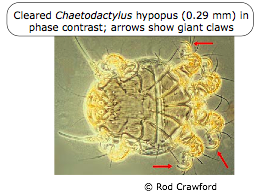As bees emerge from the infested nest, they may crawl through an infested cell. When they do, they instantly acquire an overload of hitch-hiking mites in the hypopus stage, often enough to cripple the bees from flight. The mites at this stage [since they lack mouthparts] do not feed on the bee. Among the mites remaining in the nest are encysted individuals which look like pearly eggs and are found in small cracks or other hideaways. These apparently wait until later in the season before before emerging to re-infest a new nest in the same cavity, made by either another BOB or a related species. We don't know much about the cysts. [They are actually a second, sedentary type of hypopus with reduced legs.]
The mites therefore kill host bees at two stages, egg or early larva and adult, because of completely different activities. We currently have no method of managing the mites, although keeping BOBs in paper tube inserts is helpful because it allows heat sterilization of the wooden block (to kill cysts) in the winter after the nests have been removed. Also, the tubes can be cut open to survey for the mites, which eventually may facilitate mite control. BOBs kept in bare wood blocks are basically helpless against this pest.

We have learned little since the pioneering reports of Krombein and Baker. More research is badly needed to find an effective management system for the mite. Some private indivuduals, including some Scarabs, are currently experimenting with various miticides to kill the mites at various stages in their life cycle, but trying to insert these safely into the life cycle of the host bee is difficult. The USDA Bee Biology & Systematics Lab in Logan, Utah is aware of the problem, and may soon include the hairy-footed mite in its research program. In Japan, a similar mite infests native populations of the Japanese hornfaced bee, an important fruit pollinator. The Japanese have had some success in controlling their mites with miticides and heat shock.
